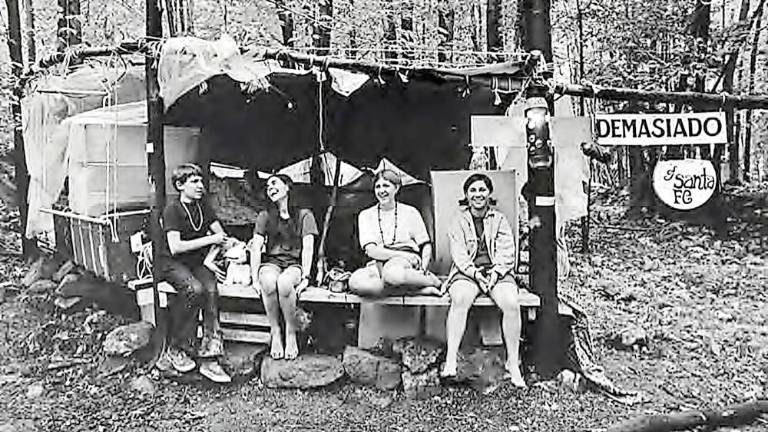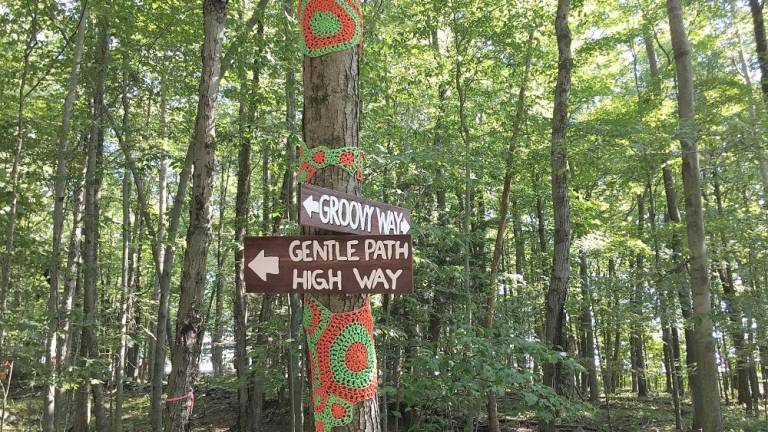Take a walk through Woodstock history on the Bindy Bazaar Trail
Bethel. The Bindy Bazaar is an important cultural landmark that “exemplifies the informal, free-wheeling spirit of the counterculture.”


Join Sullivan Renaissance at Bethel Woods Center for the Arts for a gentle walk through history on the Bindy Bazaar Trail.
Eleanor Hein, Landscape Preservation Fellow, and museum staff will led the walk at 6 p.m. on Thursday, Aug. 5. They will talk about the preservation of this historic trail, which was part of the Bindy Bazaar at the Woodstock music festival in August 1969. This phase of the project was funded in part by a Sullivan Renaissance Healthy Community Initiatives grant.
“I look forward to sharing the magic that has been instilled here,” said Hein. “It is alive in the landscape, and it will continue to live through the hearts and minds of those who come to experience it for themselves.”
A symbol of 1960s counterculture, Woodstock started as a profit-making venture then became a free-for-all once the site was overrun. At the Bindy Bazaar, cash was out and barter was in, with attendees encouraged to create trinkets and trade whatever they had on hand.
Binghamton University’s Public Archaeology Facility (PAF) worked with The Museum at Bethel Woods and Bethel Woods Center for the Arts to dig at the site of the original Woodstock Music and Art Fair. In 2018, PAF archaeologists determined the exact location of the stage and more recently identified cultural features to help the museum construct a trail system based on plans from the Woodstock archives. By analyzing the rocks and vegetation surrounding the area, the team identified 24 vendor booths and 13 other potential cultural features in the Bindy Bazaar area.
Maria O’Donovan, project director, said the Bindy Bazaar is an important cultural landmark that reflects the spirit of the festival. “The Bindy Bazaar was a meeting place where transactions — which included trading and bartering, in addition to selling — and cultural interactions took place,” she said. “It exemplifies the informal, free-wheeling spirit of the counterculture.”
She said this discovery reveals the exciting spontaneity of Woodstock.
“Our research demonstrated that the reality of what occurred at Woodstock was not captured by the preliminary plans,” O’Donovan said. “This is more evidence that the festival took on a life of its own that organizers could not control.”
Hein, who earned a bachelor of arts in hospitality management and a minor in archaeology and anthropology from Mercyhurst University in Erie, Pa., began working for The Museum at Bethel Woods in February as the Landscape Preservation Fellow. Hein has been assisting Senior Curator Dr. Neal Hitch in creating planning documents, drawings, and reports in order to produce location-based historic landscape interpretive strategies, as well as developing unique programming to engage guests with Bethel Woods.
Wear hike-appropriate footwear for the Aug. 5 walk. Pack rain gear in case of showers.
The event will be limited to 40 participants (no dogs, please). Families are welcome. Register at sullivanrenaissance.org.
Sullivan Renaissance is a beautification and community development initiative principally funded by the Gerry Foundation with support from Assemblywoman Aileen Gunther, Bold Gold Media Group, The River Reporter, The Sullivan County Democrat, and WJFF Radio Catskills.
To learn more about the trails, visit BethelWoodsCenter.org.